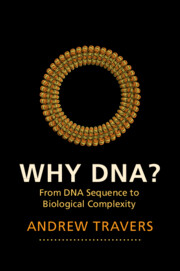Book contents
- Why DNA?
- Frontispiece
- Why DNA?
- Copyright page
- Contents
- Preface
- Acknowledgements
- 1 The Perennial Question
- 2 The Nature of Biological Information
- 3 DNA
- 4 The Evolution of Biological Complexity
- 5 Cooperating Genomes
- 6 DNA, Information and Complexity
- 7 Origins of Complexity
- 8 The Complexity of Societies
- 9 Why DNA
- General Reading and Bibliography
- Index
7 - Origins of Complexity
Published online by Cambridge University Press: 05 May 2022
- Why DNA?
- Frontispiece
- Why DNA?
- Copyright page
- Contents
- Preface
- Acknowledgements
- 1 The Perennial Question
- 2 The Nature of Biological Information
- 3 DNA
- 4 The Evolution of Biological Complexity
- 5 Cooperating Genomes
- 6 DNA, Information and Complexity
- 7 Origins of Complexity
- 8 The Complexity of Societies
- 9 Why DNA
- General Reading and Bibliography
- Index
Summary
At the heart of the central issue of the origin of life and genetic information lies Schrödinger’s simple question, ‘What is life?’ or more precisely, ‘What is the physical nature of life?’ In essence life is a highly complex carbon-based chemical system that is maintained far from chemical equilibrium by a constant influx of energy. The rates of the chemical reactions maintaining the flux of metabolites in a cell are enhanced, according to the Law of Mass Action, by the utilisation of high local concentrations. These can take the form of absolute high concentrations, the precise localisation of a reaction substrate at the reaction centre of an enzyme and the catalysis of successive reactions in a pathway by an array of catalytic centres, ordered on a physical platform – effectively a module acting as a factory. But which of these characteristics can reasonably be regarded as fossils reflecting the primitive origins of life chemistry and which simply conserve subsequent crucial innovations in life’s evolution? Evolution is of course a largely continuous and incremental process but is punctuated by ‘emergent’ events that may provoke a step change in evolutionary trajectory.
- Type
- Chapter
- Information
- Why DNA?From DNA Sequence to Biological Complexity, pp. 154 - 170Publisher: Cambridge University PressPrint publication year: 2022

